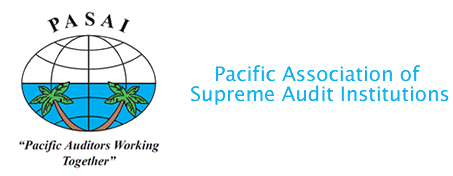IntoSAINT –
A tool to assess the integrity of Supreme Audit Institutions.
Workstream motto: “Keep trust safe“.
Supreme Audit Institutions cannot be effective without the trust of our auditees, parliaments and citizens. Trust needs to be earned, therefore the (perceived) integrity of the SAI is a crucial factor. That is why SAIs need IntoSAINT, a tool to assess the vulnerabilities and the maturity of the integrity controls of SAIs and to strengthen integrity in SAIs. Once the SAI sets the example, the focus can shift to integrity of the national public sector.
About IntoSAINT
Since 2017 the SAI of Mexico has chaired the CBC workstream of IntoSAINT, taking over the responsibility from the Netherlands Court of Auditors.
The CBC IntoSAINT workstream supports the global roll-out of the IntoSAINT-tool.
The objectives of the workstream are :
- Broad recognition of IntoSAINT as a capacity building and assessment tool for SAIs
- Worldwide application of IntoSAINT in order to strengthen integrity in SAIs and the public sector;
- Mainstream IntoSAINT in SAIs and regional organizations’ strategies and operations;
- Demonstrate added value by developing a monitoring system and actively promoting experiences and best practices via existing INTOSAI communications channels;
- Ensure synergies between IntoSAINT roll-out and regional activities to support ISSAI 12 and to implement SAI-PMF, ISSAI 30 and the IDI Fraud and Corruption programme.
- Continue lobbying for SAIs to dedicate own budget as well as for donor support to fund the roll-out of IntoSAINT.
Introduction to IntoSAINT
Ongoing Activitites
During the INCOSAI 2016 in December in Abu Dhabi, the Netherlands Court of Audit will be proud to hand over the chair to the SAI of Mexico. The new motto of the IntoSAINT CBC workstream will be KEEP TRUST SAFE. Over the years Mexico managed to roll-out IntoSAINT not only three times in its own institution, but also in the audit institutions of the federal states of Mexico. In addition Mexico coordinated the roll out in Latin America. This is quite an achievement and all INTOSAI-regions can learn from the good practices of OLACEFS. The Netherlands Court of Audit will remain member of the CBC workstream and keep on contributing to the goals.
Documents - Progress reports
Minutes of meeting
Working group meetings 2023
Minutes 28 February 2023 with adaptations
Working group meeting 1-2 June 2020
IntoSAINT working group meeting June 2020 (final)
IntoSAINT Summary Conclusions Global meeting in Mexico City 2018
Line 1: The IntoSAINT Tool
IntoSAINT: a tool to assess the integrity of Supreme Audit Institutions
The concept of integrity
Integrity is not a simple concept to define. Many overlapping and distinct definitions are used. The term integrity is derived from the Latin in-tangere, meaning untouched. It refers to virtue, incorruptibility and the state of being unimpaired. Integrity is closely related to the absence of fraud and corruption, but it also entails common decency. In this context, it is a positive and broad concept related to ethics and culture. The SAINT tool uses a broad and positive definition of the term integrity.
Integrity means more than simply observing rules and laws. The law provides a lower limit and a minimum moral starting point. An integrity policy calls for a combination of repression and prevention. On the one hand, an organization must adopt measures to take if its staff act inappropriately (repression). On the other, it must do all it can to remove temptations that might induce civil servants to act inappropriately (prevention). Priority should be given to prevention. Not only is it is more effective, but on balance the investment is many times smaller than the cost of repairing damage caused by inappropriate behavior.
The IntoSAINT tool
IntoSAINT is targeted at corruption prevention and leads to management recommendations to support the integrity of the organisation. It is a ‘qualitative tool’ that enables the user to design a tailor made integrity policy and at the same time increase the integrity awareness of employees.
The basic principles of IntoSAINT
- Self-assessment: SAINT is a self-assessment tool. The organization itself must take the initiative to test its integrity. Thus, the assessment draws on the knowledge and opinions of the staff. The organization reveals its own weaknesses and the staff make recommendations on how to strengthen resilience.
- Targeted at prevention: The self-assessment tool is targeted at prevention. It is not designed to detect integrity violations or to punish (repress) unacceptable conduct but to identify the main integrity weaknesses and risks and to strengthen the organization’s resilience in the face of those weaknesses and risks.
- Raising general integrity awareness: The IntoSAINT workshop significantly increases awareness of integrity. The participants’ collective discussions about the importance of integrity are of great value.
- Learning to think in terms of vulnerability and risk: The IntoSAINT workshop teaches the organization how to think in terms of vulnerability and risk. During the workshop, the participants identify the main vulnerabilities and risks and then make recommendations on how to minimize them.
- Concrete management report/action plan: The end product of the IntoSAINT workshop is a concrete management report/action plan. Under the expert leadership of a trained moderator, the participants formulate recommendations for their own organization. The report explains to management where urgent measures must be taken to strengthen the organization’s resilience in response to integrity violations.
Line 2: The IntoSAINT Roll Out
The IntoSAINT Roll Out
After INCOSAI in Johannesburg in 2010 the global roll-out started. The tool became available for all INTOSAI members, provided they participate in facilitator-trainings, join the regional resource pool of facilitators, co-operate to improve this instrument and exchange experiences systematically on an voluntary basis. Since INCOSAI Beijing (2013) the roll-out is done by regions with support of the CBC workstream. At INCOSAI Abu Dhabi the chair of the workstream was handed over to the SAI of Mexico. Under their leadership we will work on the roll-out in the regions and on mainstreaming the tool, sharing experiences and good practices.
Please see below how IntoSAINT has spread already. On the left is a map showing countries with certified IntoSAINT moderators, on the right is a map showing the countries that have had IntoSAINT workshops.

Interested? Please contact your regional contact and/or the chair of the CBC workstream.
Line 3: IntoSAINT Newsletters
IntoSAINT Newsletters
The IntoSAINT post keeps the INTOSAI community up to date on recent developments and initiatives. Of course this depends on the regions! Please send your contributions for the next post to IntoSAINT@asf.gob.mx.
Posts:
- April 2012
- February 2013
- July 2013
- November 2013
- April 2014
- December 2014
- November 2015
- March 2016
- December 2016
IntoSAINT Guides and Tools
IntoSAINT Manuals
Members
- South Africa/AFROSAI-E
- Tunisia/ARABOSAI
- Iraq/ARABOSAI
- Indonesia/ASEANSAI
- Philippines/ASOSAI
- Jamaica/CAROSAI
- Cameroon/CREFIAF
- Netherlands/EUROSAI
- Mexico/OLACEFS
- New Zealand/PASAI
- IDI
Contact information
SAI Mexico
Mr. David Rogelio Colmenares-Páramo, Auditor General
Supreme Audit Institution of Mexico
Tel. +52(55) 5449 8937.
Website: www.asf.gob.mx
IntoSAINT: IntoSAINT@asf.gob.mx
Direction of Multilateral Relations
Ms. María José Franco Rodríguez
Email: mjfranco@asf.gob.mx
Tel. + 52 (55) 52 00 15 00 ext. 10731
INTOSAI Liaison
Mr. José Francisco De Villa Soto
Email: jfvilla@asf.gob.mx
Tel. + 52 (55) 52 00 15 00 ext. 10652
News

Blog: Four Essential Skills for Auditors in the “Next Normal” Era
The role of auditors is rapidly evolving due to technological advancements, regulatory changes, and global challenges like the COVID-19 pandemic. As we enter the "Next Normal" era, auditors need to be equipped with key skills to effectively operate in this complex...

Upcoming AFROSAI-E workshops in July
2-5 July: Annual Extractive Industries workshop in Dar es Salaam Over the years, our annual Extractive Industries Workshop has proven to be an invaluable gathering of representatives from member SAIs, industry experts, and practitioners from various institutions. This...

PASAI blog: Firefighting, saving lives and the value of Performance Audit
Read and be inspired by this blog by By Mike Scott, Director Performance Audit, PASAI: "...This got me thinking about the value of performance audit and how being a performance auditor isn’t as different as it might seem to being a firefighter. Being capable, timely...

Blog: How a culture’s ‘power distance’ affects auditing
By Luke Eaton, Communications Advisor, PASAI Across the Pacific region the power distance dimension of culture varies. This refers to the relationships between people perceived to have different ‘statuses.’ In places with a low power distance, interactions are usually...

16-20 September intense meeting week hosted by SAI Romania
Building Effective, Accountable and Transparent Institutions for the Public Good There will be a busy meeting week in Bucharest, Romania, on 16-20 September. The meetings of IDC (INTOSAI-Development Cooperation), PFAC (INTOSAI Policy, Finance and Administration...

AFROSAI-E Bulletin no. 1, 2024
The Office of the Auditor General of Uganda played a crucial role in hosting the 20th AFROSAI-E Governing Board Meeting and 2024 Strategic Review in the beginning of May. The event was attended by over 130 delegates, including the Auditors General from member SAIs,...

PASAIs strategy 2024-2034: Investing in Integrity
While every Congress is a major event on the PASAI calendar, this year marks a significant milestone with the adoption of the new strategy for 2024–2034. The strategy is the result of more than a year’s collective efforts. Please read the summarizing blog of Sarah...

First meeting of the Task force on Citizen Participation (TFCP)
Sharing experiences, results and perspectives on citizen participation and civil society engagement by Nelson Shack Yalta, Comptroller General of the Republic of Peru and Chair of the Task Force on Citizen Participation and Civil Society Engagement...

PASAI: new HR guide now available
A new guide is now available to help Pacific Island SAIs navigate human resource management (HRM), providing the tools to deal with the challenges of attracting, developing, rewarding and retaining staff, based on global knowhow and regional experience. Find...

The future of flexible working in Supreme Audit Institutions
In recent years the CBC has focused on human resource management issues, recognizing that staff are the most crucial asset of a Supreme Audit Institution (SAI). Human resource management encompasses various dimensions aimed at optimizing staff performance and ensuring...

